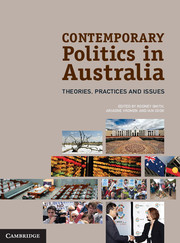Book contents
- Frontmatter
- Contents
- Tables and figures
- Contributors
- Acknowledgements
- Introduction
- I Contemporary Theories of Australian Politics
- Part II Politics in Everyday Australian Life
- Part III Elections
- Introduction to Part III
- 11 Electoral rules
- 12 Political parties as electoral players
- 13 Campaigns and campaign funding
- 14 Voter behaviour
- Part IV Participation and Representation
- Part V Inside the Australian State
- Part VI Contemporary Public Controversies
- Glossary
- References
- Index
Introduction to Part III
from Part III - Elections
Published online by Cambridge University Press: 05 June 2012
- Frontmatter
- Contents
- Tables and figures
- Contributors
- Acknowledgements
- Introduction
- I Contemporary Theories of Australian Politics
- Part II Politics in Everyday Australian Life
- Part III Elections
- Introduction to Part III
- 11 Electoral rules
- 12 Political parties as electoral players
- 13 Campaigns and campaign funding
- 14 Voter behaviour
- Part IV Participation and Representation
- Part V Inside the Australian State
- Part VI Contemporary Public Controversies
- Glossary
- References
- Index
Summary
Elections are times when all Australians feel most immediately affected by politics. Stories about politics lead every radio and television news broadcast and provide front-page stories in newspapers. Political bloggers become more active. Advertisements appear regularly in the electronic and print media. Posters promoting candidates spring up overnight in our neighbourhoods. For those of us who study politics, elections are also some of the most interesting and engaging times. Everyone’s attention starts to turn to politics, whether we like it or not.
One of the most intriguing features of elections for political scientists, casual observers and participants alike is their uncertainty. Every election has the potential to confirm existing political patterns, to open up new political possibilities, or to do a bit of both. This theme of contending electoral possibilities was well captured in the title of the first major Australian study of electoral behaviour, Don Aitkin’s (1982) Stability and Change in Australian Politics. Some 30 years on, this part of our book demonstrates that debates over the extent, character, causes and consequences of electoral stability and change in Australia are very much alive.
- Type
- Chapter
- Information
- Contemporary Politics in AustraliaTheories, Practices and Issues, pp. 118 - 119Publisher: Cambridge University PressPrint publication year: 2012

